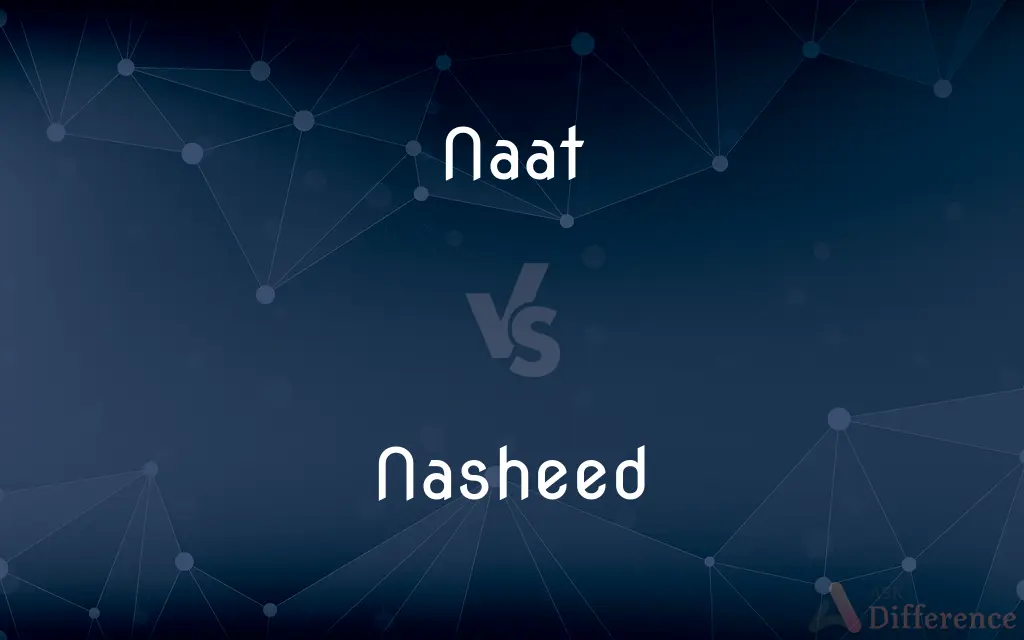Naat vs. Nasheed — What's the Difference?
By Maham Liaqat & Urooj Arif — Updated on March 22, 2024
Naat is a poetic form exclusively praising the Islamic prophet Muhammad, often performed in Urdu or Arabic, while Nasheed is an Islamic vocal music genre, sung a cappella or with percussion, focusing on various Islamic themes.

Difference Between Naat and Nasheed
Table of Contents
ADVERTISEMENT
Key Differences
Naat is a form of poetry that specifically praises the Prophet Muhammad, deeply rooted in the Muslim culture, particularly in South Asia. On the other hand, Nasheeds are Islamic-oriented songs that can cover a wide range of themes from spirituality, religion, and daily life to social issues and morality. Unlike Naats, Nasheeds are not restricted to praising the Prophet Muhammad and can be performed in various languages, reflecting the diversity within the Muslim world.
The performance style of Naats is often solemn and deeply emotional, aiming to evoke feelings of love and respect for the Prophet among the listeners. Reciters of Naat, known as Naat Khawan, employ a melodious, rhythmic tone to convey the poetry's beauty and depth. Whereas Nasheeds, performed by Nashid artists, vary widely in style from traditional to contemporary, adapting to global musical trends while maintaining a clear Islamic thematic focus. This flexibility in Nasheed allows it to appeal to a broader audience, including the younger generation.
Lyrically, Naats are rich in literary devices, drawing from classical poetry's depth, using metaphors, similes, and allegories to describe the Prophet's characteristics and deeds. This complexity adds a layer of intellectual engagement for the audience, requiring some understanding of Islamic history and Arabic or Urdu language nuances. In contrast, Nasheeds tend to be more straightforward in their lyrics, aiming to inspire, educate, or comfort, making them more accessible to people of all ages and backgrounds.
In terms of context and usage, Naats are predominantly featured in religious gatherings, mosques, and during Islamic festivities. They are an integral part of the spiritual atmosphere, creating a sense of connection and communal celebration. Nasheeds, however, find a wider range of applications, from educational settings, such as Islamic schools, to entertainment and social gatherings, offering both spiritual content and moral guidance.
The audience for Naats and Nasheeds also differs, with Naats appealing primarily to those with a deep reverence for Islamic traditions and the Urdu or Arabic languages. Nasheeds, on the other hand, cater to a broader, more diverse audience, including non-Arabic speakers, and have gained popularity on international platforms, including social media and music streaming services, showcasing the genre's adaptability and wide appeal.
ADVERTISEMENT
Comparison Chart
Definition
Poetry praising Prophet Muhammad
Islamic vocal music with various themes
Language
Primarily Urdu or Arabic
Multiple languages
Themes
Exclusively praises the Prophet
Broad, including spirituality, morality, and social issues
Performance
Solemn, often without instruments
Can be a cappella or with percussion
Audience
Muslims with a deep respect for Islamic traditions
Broader, diverse Muslim and non-Muslim audience
Compare with Definitions
Naat
Focuses on the Prophet's life and virtues.
The Naat highlighted the Prophet's humility and kindness.
Nasheed
Covers spirituality, daily life, and social issues.
The Nasheed advocating for peace was inspiring.
Naat
Engages Muslims deeply rooted in tradition.
The gathering was moved by the Naat, reflecting their love for the Prophet.
Nasheed
Appeals to a broad, diverse audience.
The Nasheed attracted listeners from various backgrounds.
Naat
A religious poem praising the Prophet Muhammad.
During the Milad, a Naat praising the Prophet's compassion was recited.
Nasheed
Sung in a variety of languages.
The English Nasheed made the message accessible to all attendees.
Naat
Primarily in Urdu or Arabic.
The Urdu Naat captivated everyone with its eloquence.
Nasheed
Islamic vocal music that may include a wide range of themes.
The Nasheed about brotherhood resonated with the audience.
Naat
Often recited without musical instruments.
His voice filled the room as he recited the Naat a cappella.
Nasheed
Can include percussion instruments.
The rhythmic percussion complemented the Nasheed beautifully.
Naat
(Islam) poetry in praise of the prophet Muhammad
Nasheed
A nasheed (Arabic: singular نشيد nashīd, plural أناشيد anāshīd, meaning: "chants") is a work of vocal music, partially coincident with hymns, that is either sung a cappella or with instruments, according to a particular style or tradition within Islam. Nasheeds are popular throughout the Islamic world.
Nasheed
A song, often Islamic, consisting of vocals either sung a cappella or accompanied by percussion instruments.
Common Curiosities
Can Nasheeds be performed with instruments?
Yes, Nasheeds can be performed a cappella or with percussion instruments, within Islamic guidelines.
What is a Nasheed?
A Nasheed is an Islamic vocal music genre, focusing on various themes, and can be sung a cappella or with percussion.
What role does language play in the appeal of Naats and Nasheeds?
The language of Naats (primarily Urdu or Arabic) often requires specific cultural or religious knowledge for full appreciation, whereas Nasheeds, being more linguistically diverse, are accessible to a broader audience.
How do performance styles differ between Naat and Nasheed?
Naats are usually solemn and deeply emotional, while Nasheeds can range from traditional to contemporary, including rhythmic and musical variations.
In what languages are Naats primarily recited?
Naats are primarily recited in Urdu or Arabic.
Can children and teenagers relate to Nasheeds?
Yes, the thematic and stylistic diversity of Nasheeds makes them relatable to younger audiences, including children and teenagers.
Are there any restrictions on the content of Naats and Nasheeds?
Both must adhere to Islamic principles, with Naats specifically focusing on praise of the Prophet and Nasheeds avoiding themes that contradict Islamic teachings.
What is a Naat?
A Naat is a poetic form in Islam praising Prophet Muhammad, often recited in Urdu or Arabic.
How do Naat and Nasheed differ in themes?
Naat exclusively praises Prophet Muhammad, while Nasheed covers a wide range of Islamic and social themes.
What makes a Nasheed appealing to a wider audience?
Its thematic diversity, use of multiple languages, and adaptation to contemporary musical styles make Nasheed appealing to a wider audience.
Are Naats only recited in religious contexts?
While primarily featured in religious contexts, Naats can also be appreciated in cultural settings for their literary and artistic value.
Can Naats be listened to by non-Muslims?
Yes, anyone can listen to Naats, but understanding and appreciation are enhanced with knowledge of Islamic traditions.
Share Your Discovery

Previous Comparison
Lap vs. Sleep
Next Comparison
Algorithm vs. FormulaAuthor Spotlight
Written by
Maham LiaqatCo-written by
Urooj ArifUrooj is a skilled content writer at Ask Difference, known for her exceptional ability to simplify complex topics into engaging and informative content. With a passion for research and a flair for clear, concise writing, she consistently delivers articles that resonate with our diverse audience.
















































